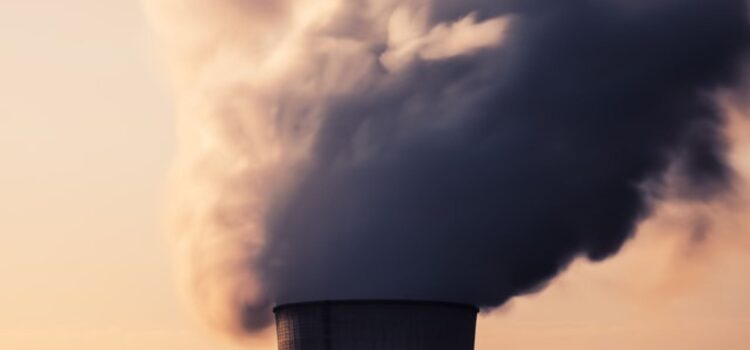
This is a free excerpt from one of Shortform’s Articles. We give you all the important information you need to know about current events and more.
Don't miss out on the whole story. Sign up for a free trial here .
What is carbon capture technology? What are the pros and cons of carbon capturing? Is it a reliable way to avoid climate catastrophe?
In March, the U.N. released a report declaring that without an immediate shift away from fossil fuels, the world will confront a climate catastrophe. Experts say the US must meet carbon emission reduction goals faster and that carbon capture technology will help get us there, but others remain skeptical.
Read on to learn what carbon capture technology is and experts’ views on its benefits and drawbacks.
Can Carbon Capture Technology Save Us?
In late March, the U.N. Intergovernmental Panel on Climate Change (IPCC) released a report revealing that without an immediate shift away from fossil fuels, in ten years the world will surpass a precarious temperature threshold and confront climate disasters so severe that humans will not be able to adapt. Resulting famines, infectious diseases, and heat waves could kill millions by century’s end. Experts say the US and other wealthy nations must take steps to meet their carbon emission reduction goals faster. Some argue that carbon capture technology is key to doing this, but what is carbon capture technology?
This article will examine experts’ varied viewpoints on carbon capture technologies, including why carbon needs to be captured and if these technologies can help avert global climate catastrophe.
What Is Carbon Capture Technology?
So, what exactly is carbon capture technology? “Carbon capture” refers to technologies used to either remove carbon dioxide from the atmosphere or trap and store emissions before they enter the air. Carbon needs to be captured because humans, through fossil-fuel use, are producing CO2 faster than the earth’s natural ecosystems (wetlands, forests) can absorb it.
Two types of technology can supplement the planet’s natural ability to absorb CO2:
- Post-combustion capture. This primary method of US carbon capture absorbs about 24% of global carbon emission in the form of “flue gas,” which comes from smokestacks of coal and natural gas power plants and factories that produce concrete and steel.
- Direct air capture. This still-new technology—which some experts say is a key part of achieving net-zero emissions by 2050—uses specialized equipment to extract CO2 directly from the atmosphere.
Once captured and separated, CO2 is pressurized into a liquid state for transport to a pipeline for use (for example, to extract crude oil from the earth or carbonate drinks) or storage deep underground.
Pro: It’s a Key Part of the Solution
Now that we understand what carbon capture technology is, let’s explore experts’ viewpoints on the pros and cons of relying on carbon capturing. Carbon capture proponents, including the IPCC, some environmental groups, and the federal government support the technology as one part of a broader strategy to reduce CO2 emissions. They argue that:
- No perfect emissions reduction solution exists, so it’s necessary to embrace all technologies that can help prevent catastrophic climate change.
- Carbon capture is the only viable technology to capture emissions for certain industries, like cement-making and steel production.
In 2021, Congress allocated an unprecedented $12 billion to carbon capture projects.
Con: It’s Not a Silver Bullet
Other experts contend that the US’s carbon capture strategy fails to address the challenge at hand and also creates problems, saying that:
- Carbon capture technology is “greenwashing.” Some environmental groups warn that excess focus on carbon capture technology buildout will line the pockets of energy companies that contribute to global warming while failing to address the core problem: The need to reduce fossil fuel use to prevent global climate catastrophe.
- Carbon capture technology lacks the capacity to combat CO2 emissions.
- A 2019 study revealed that carbon capture would reduce one fossil fuel-burning industrial plant’s emissions by just 10% – 11%—a full 70% – 80% lower than proponents of the technology predicted.
- A proposed 60,000 mile CO2 pipeline would only capture and store the equivalent of 15% of US greenhouse gas emissions.
- Carbon capture technology is cost prohibitive and not proven to work at scale. Use of the technology in individual industrial facilities has been successful but not profitable, leading many to abandon it for cheaper alternatives.
- CO2 pipelines can explode, as happened in Mississippi in 2020, sending 45 people to the hospital. Further, CO2 pipelines remain unregulated, a problem that could become more worrisome if three proposed carbon capture projects move forward and expand the current 5,300 miles of CO2 pipeline running across the US to more than 60,000 miles.
- Carbon capture projects could subject land owners to eminent domain. Developers of two prospective CO2 pipeline projects in the Midwest have indicated that they will, if necessary, forcibly take land from farmers who refuse to give them permission to bury and maintain pipeline on their land.
Opinion: Significantly Curbing Carbon Emissions Will Be Nearly Impossible
In Numbers Don’t Lie, scientist and economist Vaclav Smil wants to help you understand the world by understanding numbers and statistics. Smil examines commonly used metrics like GDP, vaccination rates, and fertility rates and asks what they say about countries like the US, China, and Japan. He also reviews humanity’s impact on the planet through the energy, transportation, and food sectors. His perspective can also be helpful for understanding the debate surrounding the use of carbon capture technology.
Understanding Our Environmental Challenges
To help understand our environmental challenges, Smil provides the numbers for the amount of carbon we emit through the use of fossil fuels. At the beginning of the 19th century, global carbon emissions were relatively low at around 10 million tons a year. By the end of the century, that number was over half a billion tons. And by 2000, global carbon emissions were over seven billion tons a year. To put it another way, from 1800 to 2000 carbon emissions grew 650-fold while the global population only grew sixfold.
Even as governments and other organizations have started to implement large-scale efforts to curb carbon emissions, global emissions continue to grow, writes Smil. By 2017, emissions had declined in Europe and the United States, but those declines were offset by China, which contributed three billion tons of carbon emissions.
More recently, China’s increase in carbon emissions has slowed, but emissions in India and Africa are expected to continue growing, making any substantial decreases in overall global emissions unlikely. Even if we meet the targets set forth by the Paris Agreement of 2015, an international committee dedicated to reducing carbon emissions, carbon emissions would still be about 50% greater than their 2017 levels.
If we are to avoid environmental disaster, scientists estimate we need to keep global temperatures from increasing more than 1.5 degrees Celsius. According to a 2018 study, the only way to do this is to get to zero net emissions by 2050. Smil claims reaching zero emissions by 2050 will take an unprecedented global effort on a massive scale.
We Rely Too Much on Technology to Save Us From Environmental Destruction
Smil argues that many people wrongly believe technology, like carbon capture, can save us from environmental disaster. This is because they often have unrealistic expectations about the speed at which technology will advance.
These unrealistic expectations are often because people are influenced by the numbers underpinning Moore’s law, which states that the speed and capabilities of computer chips double every two years. This law has largely held true since its inception in 1965, and it has allowed for a great deal of innovation in computers and electronics.
People often assume the same rate of progress applies to other fields—for instance, in environment-related industries—but technological progress happens much more slowly outside of computer-based technologies. For example, corn yields have risen by an average of only about 2% per year since 1950, and fuel efficiency has increased by about 2.5% a year.
Instead of relying on carbon capture technology or other future technologies to save us, we should be searching for realistic and practical solutions, and if a problem can’t be completely and immediately solved, incremental progress is still better than no progress at all, contends Smil.
| Can Technology Save Us at All? A 2017 MIT study found that even in the fields of computers and electronics, where Moore’s law applies, technological advancements still aren’t enough to create a sustainable world. Some scientists believe that as we become more technologically advanced, we’ll use fewer materials and be a more sustainable society. But researchers found that no matter how much more efficiently a product is made, consumers will only demand more of that product and thus produce more material waste. For example, the amount of material to make a transistor has greatly decreased over the last few decades. This has made computers and smartphones much more powerful and compact, but the increase in demand for these superior products has outpaced further technological improvements to their sustainability. When researchers looked at materials, goods, and services outside of the electronic and computer industries, they found a similar trend: As products become smaller, better, and cheaper, demand increases, and there is no overall reduction in the amount of material used to make them. The only cases in which significant dematerialization occurs are when a product is replaced by something else (wool with nylon and polyester, for example), or the government intervenes (for instance, by passing laws against asbestos and thallium). The latter case exemplifies how practical solutions are more effective than reliance on not-yet-discovered technologies: Asbestos was discovered to be hazardous, so the US government passed a law limiting the production and use of asbestos. |

Want to fast-track your learning? With Shortform, you’ll gain insights you won't find anywhere else .
Here's what you’ll get when you sign up for Shortform :
- Complicated ideas explained in simple and concise ways
- Smart analysis that connects what you’re reading to other key concepts
- Writing with zero fluff because we know how important your time is






